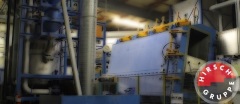Expanded Polystyrene has been the proven answer to common packaging, insulative, and construction material solution for decades. It is unique in that it is a closed cell, rigid, polymeric material that is about 95% air. The distinctive white pre-expanded beads are very recognizable, and display the resin identification code number.
Introduction
Expanded Polystyrene, or EPS, goes through a series of changes that take it from a small polystyrene pre-expanded bead about 1mm in width to an expanded bead forty times that diameter. The process of pre-expansion involves very precise measurements of timing, pressure variables, and high temperature steam in our Hirsch-Gruppe pre-expander and a blowing agent called Pentane (similar in chemical structure to Methane). The process of pre-expansion is vital when it comes to determination of just how the resultant block of foam and its density is produced.
Pentane and EPS Bead Expansion
The magic of Pentane as a blowing agent is the vital component to making EPS foam. Pentane is a colorless organic liquid hydrocarbon and is usually considered a “specialty solvent” that has a very distinctive smell. Pentane is used in the EPS industry to replace former CFC producing blowing agents of the past. It is an ingredient in aerosol propellants, refrigerants, pesticides, and used for the production of other chemicals. The transformation in the bead takes place when the Pentane inside the bead changes to a gas due to the high temperature steam (approx. 270 degrees) being applied while it is revolving in the pre-expansion chamber. The beads slowly begin foaming or “puffing up” from their tiny size to 40 times their original diameter. Here the settings and parameters in the Hirsch-Gruppe pre-expander are critical to what those beads eventually become, and to what application of density the EPS foam block is to be made into.
Give the Beads a Rest
After the expanded EPS beads are at the designated size, they are then sucked out of the pre-expander and into large storage silos like the picture on the left. Once in the silos, the beads have to dissipate excess Pentane and age anywhere from 48 to 72 hours so EPS foam block stability and the fabricating of the foam block can be done properly.
Into the Hirsch-Gruppe Foam Block Machine
After the beads have been aged properly, they are then pumped into our state-of-the-art Hirsch-Gruppe foam block mold machine. Michigan Foam Products uses the Hirsch-Gruppe foam block mold machine because of its precision, reliability, and production capabilities. With the combined experience of our block mold techs and the computer precision quality of our Hirsch-Gruppe block mold, block consistency is guaranteed. To make a simple EPS block, our techs program at least forty separate parameters into the CNC console. Each block takes anywhere from 5 minutes to 18 minutes (depending on density) to complete the high pressure forming of each block. Once again, high temperature steam and a great deal of internally applied pressure make those beads, and the rest of the Pentane in them, form into a solid block of foam. Once that block exits the block mold it is taken to a holding area and set on end vertically to dissipate the remaining Pentane and heat within the block that occurred during the molding process. This also takes a couple days to finish.
Fabrication
When needed, the EPS foam blocks are transported to a variety of hot wire cutting machines. Some of the hot wire cutters such as a profile cutter, can take a 3D CAD drawing and turn that huge block of EPS foam into every shape imaginable, whether 2D or 3D, flat or round, and do it with total CNC precision. And other large hot wire cutting machines like the “Autowire Cutter” on the right, are designed to cut straight width foam sheets anywhere in size from ¼ up to the width of a full block. Each of the larger hot wire cutters have CNC controls to feed in necessary measurements to make thousands of different sizes of parts and pieces with precision.
For a detailed examination of the way Expanded Polystyrene is manufactured, this doctoral thesis done by Olita Medne of Riga Technical University is very thorough and well worth the study if you desire details and analysis.

At a distant naval base in Okinawa Japan, U.S. Naval Mobile Construction Battalion Five completed a five-day training program constructing what is called an “alternative building structure” made entirely out of Expanded Polystyrene Foam and a thin layer of a specialty concrete mixture that was troweled on both outside and inside the dwelling when the walls and roof were completed. Once the concrete layer rated as being able to withstand hurricane winds and earthquakes. This type of EPS shelter will be implemented later on in the Philippines, Malaysia, Indonesia and Thailand.
Typical Properties of Expanded Polystyrene






